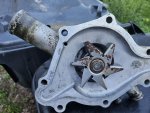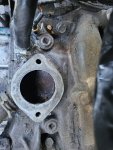I purchased a '77 Dodge M882 (Comm truck) last week because I miss my old '74 Dodge W200 that I sold off years ago. Truck has great potential with almost no rust, but I have spent the last 3 days trying to get it road-ready and have run into a cooling system issue that doesn't even seem possible.
I first noticed something was off when I went to remove the radiator cap after it sat over-night and was met with a coolant bath...it was under pressure. It has a new aluminum radiator and over-flow tank, yet the system was under pressure. I also noticed that the lower radiator hose was leaking so I replaced that and refilled the radiator to about 1 inch below the neck. I left the cap off so I could look for any signs of combustion gas or oil mixing, plus I wanted to be ready to top it off after the t-stat opened.
Well, the truck idled for about 3 minutes, no bubbles or mixing present in the radiator. Then I started to see some coolant movement and the upper hose heat up so the t-stat was beginning to open. I walked over to the cab to grab a jug of coolant when the radiator turned into a volcano of scalding coolant all over the engine bay before I could shut down.
Now, I had already given the truck an oil change and tune-up and saw no signs of coolant issues in either one. There is no smoke or steam out of the exhaust either. Coolant was clean as well and yet my radiator blew up on me. I have never experienced anything like this and I admit to being fully stumped by it....and a little angry. I plan to pull the t-stat and run it again with constant flow to see what happens, but I don't know if that will really solve the mystery.
The truck runs and idles great, smooth and responsive, I have fixed up a dozen things already and ready to get it on the street to find out what I have, but this cooling system mystery has me at a loss.
I first noticed something was off when I went to remove the radiator cap after it sat over-night and was met with a coolant bath...it was under pressure. It has a new aluminum radiator and over-flow tank, yet the system was under pressure. I also noticed that the lower radiator hose was leaking so I replaced that and refilled the radiator to about 1 inch below the neck. I left the cap off so I could look for any signs of combustion gas or oil mixing, plus I wanted to be ready to top it off after the t-stat opened.
Well, the truck idled for about 3 minutes, no bubbles or mixing present in the radiator. Then I started to see some coolant movement and the upper hose heat up so the t-stat was beginning to open. I walked over to the cab to grab a jug of coolant when the radiator turned into a volcano of scalding coolant all over the engine bay before I could shut down.
Now, I had already given the truck an oil change and tune-up and saw no signs of coolant issues in either one. There is no smoke or steam out of the exhaust either. Coolant was clean as well and yet my radiator blew up on me. I have never experienced anything like this and I admit to being fully stumped by it....and a little angry. I plan to pull the t-stat and run it again with constant flow to see what happens, but I don't know if that will really solve the mystery.
The truck runs and idles great, smooth and responsive, I have fixed up a dozen things already and ready to get it on the street to find out what I have, but this cooling system mystery has me at a loss.





